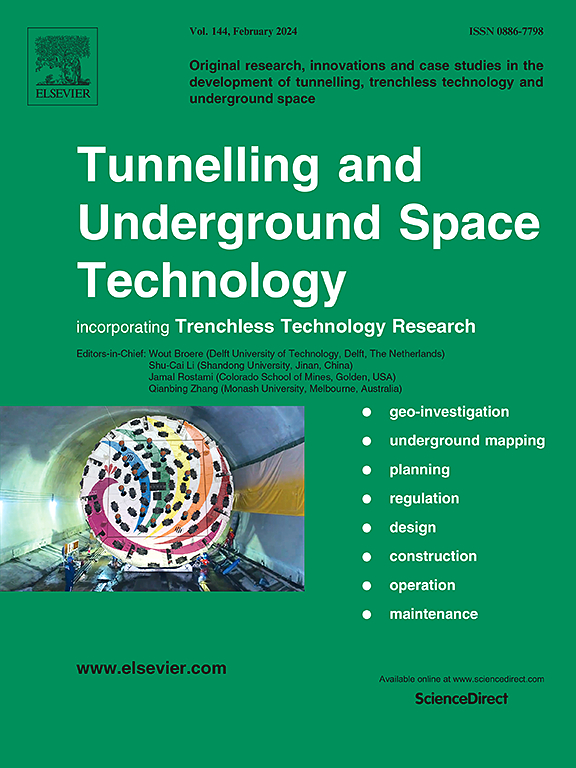任意角度斜入射横波作用下地铁车站层状场地非线性地震分析
IF 6.7
1区 工程技术
Q1 CONSTRUCTION & BUILDING TECHNOLOGY
引用次数: 0
摘要
准确捕捉地下结构在斜入射地震波作用下的地震反应,特别是当入射角超过临界值时的地震反应,一直是地震工程中的一项具有挑战性的任务。为了解决这一差距,本文提出了一个三维(3D)非线性地震分析地铁车站嵌入在一个分层场地,特别是在任意角度的斜入射剪切(SV)波的响应。引入了一种称为耦合动力刚度矩阵-有限元法(DSM-FEM)的创新方法,通过将任意传入的SV波引起的响应转换为等效节点荷载来实现地震输入。为了准确地模拟波在场地内的传播,采用了粘弹簧人工边界,同时采用了包含修正阻尼的非线性广义Masing模型。本研究以大开地铁站为基准,在考虑土-结构动力相互作用的情况下,考察了不同倾斜入射角对结构响应的影响。结果表明,当入射角接近临界值时,材料的峰值变形、内力、米塞斯应力均达到最大。超过这个临界角,地震反应明显减弱。此外,发现水平入射角的影响是明显的,导致不同结构部件的变形模式和内力的变化。具体而言,随着水平入射角的增大,漂移比、位移、剪切力、加速度和Mises应力均呈减小趋势。这些发现突出了在地震分析中考虑非垂直输入地震动的重要性,并为地下结构的结构设计和安全评价提供了有价值的见解。本文章由计算机程序翻译,如有差异,请以英文原文为准。
Nonlinear seismic analysis of subway station − layered site under obliquely incident shear waves with arbitrary angles
Accurately capturing the seismic response of underground structures subjected to obliquely incident seismic waves, particularly when the angle of incidence surpasses the critical value, remains a challenging task in earthquake engineering. To address this gap, this paper presents a three-dimensional (3D) nonlinear seismic analysis of subway stations embedded in a layered site, specifically in response to obliquely incident shear (SV) waves at arbitrary angles. An innovative procedure, termed the coupled dynamic stiffness matrix–finite element method (DSM-FEM), is introduced to enable seismic input by transforming responses induced by arbitrarily incoming SV waves into equivalent nodal loads. To accurately simulate wave propagation within the site, a viscous-spring artificial boundary is utilized, while a nonlinear generalized Masing model that incorporates modified damping is employed. Using the Daikai subway station as a benchmark, the research examines the effects of varying oblique incident angles on the structural response, taking into account dynamic soil-structure interaction. The results reveal that the maximum response, including peak deformation, internal forces, Mises stress, occurs when the incident angle approaches the critical value. Beyond this critical angle, the seismic response notably diminishes. Additionally, the influence of horizontal incident angles is found to be noticeable, leading to variations in deformation patterns and internal forces across different structural components. Specifically, it has been observed that the drift ratio, displacement, shear force, acceleration, and Mises stress exhibit a decreasing trend as the horizontal incident angles increase. These findings highlight the significance of considering non-vertical input ground motion in seismic analysis, and offer valuable insights for the structural design and safety evaluation of underground structures.
求助全文
通过发布文献求助,成功后即可免费获取论文全文。
去求助
来源期刊

Tunnelling and Underground Space Technology
工程技术-工程:土木
CiteScore
11.90
自引率
18.80%
发文量
454
审稿时长
10.8 months
期刊介绍:
Tunnelling and Underground Space Technology is an international journal which publishes authoritative articles encompassing the development of innovative uses of underground space and the results of high quality research into improved, more cost-effective techniques for the planning, geo-investigation, design, construction, operation and maintenance of underground and earth-sheltered structures. The journal provides an effective vehicle for the improved worldwide exchange of information on developments in underground technology - and the experience gained from its use - and is strongly committed to publishing papers on the interdisciplinary aspects of creating, planning, and regulating underground space.
 求助内容:
求助内容: 应助结果提醒方式:
应助结果提醒方式:


